|
Contents
Definition
of the climate symbol
The
condition of
Earth and the Universe(s).
The
Condition of Human Beings.
The
condition of Earth's atmosphere.
The
guide
to evaluating “climate education” programmes.
(provides list of keys
symbol and their potential uses)
Direct
to the list of key symbols
Note: The illustration links to
enlargements on websites do not indicate endorsement of the content of the website - any site should
be subject to full symbol evaluation before using it as education
resource.
Definition
of the climate symbol.
The origins of the symbol are: Middle
English climat,
from Old French, from Late Latin clima,
climat-,
from Greek klima,
surface of the earth, region; see klei-
in Indo-European roots
The climate
symbol now has various uses and in general they refer to the conditions
or state of affairs that characterise regions or elements of a planet
and its solar system e.g. its atmosphere, its soils, its oceans, its
core and its societies of creatures. The symbol can be used to
communicate the state of the aggregate of all these elements. Thus we can
speak of Earth’s climate as a place where all the flows and balances
of solar, carbon, oxygen, chemical-electrical, water and other requisites exist
that enable life forms to flourish.
This discussion
remains mindful of this general use and the focus is on the interaction
of two specific types of climate – the condition of the atmosphere and
the condition of humans. The “climate education” programmes being
evaluated are teaching about either one or both of these climates within
the framework of the universal climate.
The climate or conditions of planet Earth, its atmosphere and Homo
sapiens are summarised below as background information to the general evaluation strategy.

Back to top
The
condition of
Earth and the Universe(s).
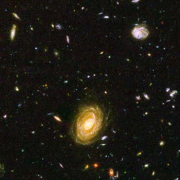
Click
on picture to enlarge at plus.maths.org
The
Conservation Principle of Energy is the most sustainable description we
have of the state of the universe(s). The energy symbol is
defined as the potential of the universes and the power symbol is
defined as the rate at which that potential is manifest. The principle
suggests that the amount of energy is so bounteous that it can be
considered a constant and cannot be created or destroyed. It also
suggests that energy is constantly transformed.
In other
words planet Earth resides within a universal flux of change and Earth
is that change. For instance, the so-called “space” around the
planet is literally fizzing
as Earth’s magnetic field interacts with the constant stream of gas
from our sun. Bubbles of
superheated gas arise and pass, forming when gas in a region drops in
density by ten times but rises in temperature from 100,000ºC to
10,000,000ºC. The bubbles expand to about 1000 kilometers and probably
last about 10 seconds before imploding and being replaced by the cooler,
denser solar wind.
While the life of
the universe(s) may be impossible to ascertain it is known that planet
Earth is a temporary phenomenon. It may exist for only about 13 billion
years with conditions enabling life forms to prevail existing for only
part of that time. Though Earth’s form may remain relatively constant
through this time its consistency is constantly changing with the
universal fluxes and flows.

The
Condition of
Human Beings.
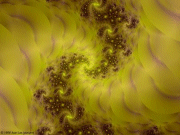
Click
on picture to enlarge at newciv.org
Population
Global impacts of population expansion
Homo sapiens as sentient and sapient beings.
Consciousness and Stewardship
Suffering
The
manifestation of energy
Compassion
The
power of symbols
Psychopathic
Corporations
All that holds
for planet Earth in the universe(s) holds for human beings. We are
temporary phenomena, both as individual beings and as a species. It is
very rare for humans to live beyond 110 years and our sub-species has
only existed for maybe 7 million years or less. Human beings are
bipedal primates belonging to the mammalian species Homo sapiens
in the hominidae family (the great apes).The symbol Homo sapiens derives
from the Latin of “wise human” or “knowing human”.
Population
The average life
expectancy and the number of human beings at any time is linked to both
variations in the state of the climate and the state of knowledge. Gene
research suggests human beings have been very close to extinction on at
least one occasion as these states varied. For instance, our populations
may have shrunk
to as few as 2000 people when we were poorly adapted to medium term
changes in Earth’s climate within the last 100,000 years. Large
societies have imploded when their state of knowledge became
unsustainable.
Estimates
are that no more than 250,000 people could have existed at any time
through the hunter-gatherer period. The population may have dropped to
as low as 2000 about in the last 100,000 years. The world
population has in general been expanding since then:
70,000 BCE (2000
people)
10,000BCE (1 million)
5,000 BCE (15
million)
500 BCE (100
million),
1
(200 million)
1000
(310 million)
1750
(791 million)
1850
(1,262 million)
1900 (1,650 million)
1950
(2,518 million)
2000
(6,070 million)
2008
(6,670 million)
At present the
human population is experiencing exponential growth. While the global
growth rate peaked in 1963 at 2.19% with the annual increase peaked in
1987 at 86 million people year. In 2000 the rate had dropped to 1.14%
and in 2007 this represents an additional increase of 1,477,630 human
beings every week. This weekly increase is a greater number than the
total number of Homo sapiens that are estimated to have existed 10,000
years ago.
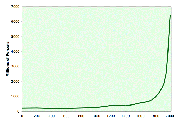
Click
on picture to enlarge at theoildrum.com
Global impacts of population expansion
Factors enabling
this exponential growth are relatively favourable climate conditions,
altered agriculture practices and an enhanced ability to use technology
to extract resources from the ground. The impact has been planetary in
scale
For instance,
about half the forests on the planet have disappeared since the last Ice
Age and the remaining 35 million square kilometers are being depleted in
many areas still. They are regenerating in some areas when humans have
cheap access to fossil fuels.
The addition of
nearly an extra 6 billion human beings in the last three hundred years
has been almost entirely sustained by an increased capacity to extract
and burn mineral fuels and to extract elements from the soil, the oceans
and the atmosphere.
Soil
formation is approximately an inch (25mm) in 1000 years. Some
researchers have estimated that current human agriculture practices are
resulting in the loss of 1% annually of the Earth’s layer of soil via
the winds and rivers through deforestation, ploughing, chemical
applications, irrigation and other activities. In the last 40-50 years one
third of the world’s arable land has been lost through erosion
and it continues to be lost at a rate more than 10Mha per year at a
global scale.
It is estimated,
for instance that the that average
US topsoil depth of 23 cm in 1776 is now down to 15 centimeters
– the US has lost (net) 1/3 of its original topsoil in 200 years and
the rate of depletion is increasing. Some estimates suggest that 5 out
of every 6 calories required to put a calorie of food on a plate comes
from fossil fuels now compared to the historic direct use of solar
resources.
Similarly it is estimated
that 90% of ocean fish over 30cms has been depleted since 1970 and it
now requires 20 times the calories (20 calories) to put a calorie of
fish on the plate of a human being as it did in 1970. Almost all of
those calories come from burning fossil fuels.
The impacts of
human activities on atmospheric balances are more difficult to quantify.
The impacts in the form of smogs are visible from Outer Space and there
is increasing evidence human activity is affecting the balances of the
Trace Gases and oxygen transformations
The impact of
Homo sapiens on the geology of the planet is so significant that some
are describing this as the Anthropocene
Age, and as is common in other ages, it is characterised by the large
waves of extinctions of species. Homo sapiens are now at very high risk
of suddenly experiencing a drastic decline in numbers and even risk
extinction. The current dependence on activities that deplete fossil
fuels, soils, fresh water and other vital resources may prove fatal. Depletion
disproportionately stems from the activities of a small minority
with the top 10% of depleters doing so a rate that is at least 20 times
that of the majority of humans and maybe a 1000 times that of the most
sustainable billion human beings.
This unsustainable
state of affairs reflects the current human condition.
Homo sapiens as sentient and sapient beings.
Homo sapiens
share the same fundamental genes and cell structures as all forms of
life on Earth. Thus we benefit from the vast computing power and
knowledge inherent in the cell structures. This has sustained the cells
through up to 3 billion years of the tectonic upheavals, solar calms and
storms, asteroid impacts, electromagnetic switches and other changes of
the planet.
All
the cells in life forms experience some form of sentience
and have the power of experiencing sensation. This enables them to
interact and adapt to change in the universe. It may be impossible for
structures such as the Homo sapiens’ form to be sentient to all
sentience and thus we cannot fully feel all that is felt. At the same
time our lack of power to sense the impact of our activities on the
flows and balances that sustain our human forms has the potential to put
us at grave risk.
Our capacity for
sentience is limited by the fact that our conscious awareness tends to
be dominated by five senses – taste, sight, sound, smell and touch and
these operate within limited ranges of the frequencies of each field.
This in turn affects our sapience.
“The word sapience
is derived from the Latin
word for wisdom,
sapientia.[2]
Both are related to the Latin verb
sapere, which means "to taste, to be wise, to know ;"
the present participle of sapere forms part of Homo
sapiens, the Latin
binomial nomenclature created by Carolus
Linnaeus to describe the human
species….
His chosen biological name was intended to emphasize man's uniqueness
and separation from the rest of the animal kingdom.”
This use of the Homo
sapiens symbol to characterise humans reveals a great deal about the
culture that has adopted it. The symbol use expresses a belief that
human beings are unique in their capacity to know, to be wise. The
culture based on these beliefs is also characterised by the most
unsustainable uses of resources. Its members are depleting resources at
least 10 times the rate that they are generated and the fossil fuel
resource will not be renewed for eons, if ever .
To
understand this phenomenon it is helpful to explore the essence of
consciousness in human beings and its potential impacts.
Consciousness and Stewardship

Click
on picture to enlarge at Scholarpedia.org
Consciousness
contains at once a sentience that all is change in the universe(s) and
also some knowledge that the human form is thus mortal.
Consciousness is also sentient of the fact that as the human form
is part of the flux and flows of change then every act affects the
balances and patterns of flows of the universe(s). With this comes an
awareness, even if only at a subliminal level, that mind and matter are
fundamentally interconnected. So with consciousness and self-awareness
comes with the realisation that every individual human being is a
steward of the balances of the fluxes and flows that sustain them.
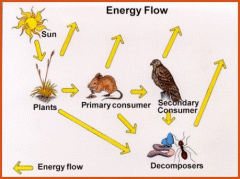
Click
on picture to enlarge at bcgrasslands.org
These flows
include the continual movement of all forms of energy through the
universe(s). It is the nature of the human form that Homo sapiens are
more sentient of some flows than others. In particular we sensitive to
social, electrical, water, carbon, oxygen and thermal flows. We can be
symbolised thus:
Social Beings
in that our society enables us to enjoy civilisation;
Electrical
Beings in that all actions and thoughts are electro-chemical flows,
we use electrical devices to communicate globally and to do much of our
lifting, pulling and pushing and we are affected by streams of
electrically charged particles flowing from the sun;
Water Beings
in that we are of the salty oceans and are constituted mainly
of water (adults,
55-65%, our brains
are 80% and babies
emerge from water, being 97% water at 3 days and 81% at eight months).
Each human being is a mini ocean and we have to constantly work to
sustain its saline balances. We experience weather as variations of
water. Hence we are very sentient of water in all its forms and
transformations;
Carbon Beings
in that the constant carbon flow through us forms the basis of much of
our cellular structure and we make use of carbon on an eonic scale;
Oxygen Beings
in that oxygen forms are essential for the combustion of food and
providing critical protection from damaging solar radiation;
And we can also
be symbolised as Trace Beings in that our existence is a trace
element of the universes, our consciousness is a trace element of our
being while the balances and flows that sustain the human form depend on
trace chemicals and trace manifestations of energy.
Suffering

Click
on picture to enlarge at ramble.martinyeoh.net
The sentience and
sapience of Homo sapiens combine to work to generate a sense of
incompleteness, of disconnection, of loneliness, of being doomed by
mortality. Human’s experience this as suffering
or pain. This state is compounded by sensations of helplessness and
guilt to the extent that Homo sapiens are aware that their actions may
be causing suffering in other creatures and that they are insufficient
stewards.
The sensation of
suffering is associated with unpleasantness, which can generate both
aversion and craving responses. The aversion response works to generate
avoidance behaviour or move the awareness from that which stimulates the
suffering sensation. The craving response works to attempt to generate
sensations that diminish awareness of the painful sensations. The two
responses share a common driver, which is a denial of
change/stewardship. The denial is manifest as loss of belief that all
sensations pass, both painful and pleasant, and as a sense of
disempowerment.
Thus arises
a fear that the sensation of suffering will dominate the consciousness
and this sensation thus becomes self-serving.
The mind of Homo
sapiens has developed a powerful capacity to create systems of knowledge
or belief based on combinations of these aversion and craving responses.
These include vast corporate/religious systems designed to rationalise
the use of these responses. The central driver of these belief systems
is the denial of both change (human mortality) and stewardship of the
universe.
The general
condition of Homo sapiens is that each human being experiences this
constant dance between sentience of the continual change, which is the
universe(s), and the painful knowledge that this means their individual
form will pass just as it has arisen from the great energy flux.
The
manifestation of energy
The ultimate sentient
experience is of energy. This can be described as the manifestation of
the potential of the universe(s). It is sensed as vast and bounteous. At the same time the knowing mind works to dictate how this
universal potential is manifest. Thus the manifestation of the potential
is subject to aversions and cravings, commonly experienced as doubt,
hopelessness, fear, greed, frustration and conflict. These sensations
affect belief systems and Homo sapiens have a tendency to create social
structures that reflect the individual’s sense of dissonance and their
net denial of change/stewardship.
Compassion

Click
on picture to enlarge at Writespirit.net
This tendency to
adopt a aversion/craving response has a counter balance and it is found in the
experience of compassion. Compassion enables Homo sapiens to acknowledge
and accept suffering. It enables us to identify the craving and aversion
responses for what they are, accept them and transcend them. It enables
us to identify and learn from flawed knowledge and belief systems. In
compassion perceived flawed beliefs and activities become symbols of
learning opportunities, not of failures. Thus our roles as stewards
become ones to be embraced, not ones to be feared and averted.
Stewardship becomes more associated with a sense of profit and less with
a sense of loss. Compassion
enables
science to exist and when that state of being exists then art,
languages, civics and all that we know as civilisation flourishes.
The
power of symbols

Click
on picture to enlarge at ngoabroad.com
All sentient
beings employ symbols to communicate whether it is at the cellular
levels in which cells transcend time and space with their DNA symbols or
it is at the level of plants and animals, including Homo sapiens, with
their use of smells, movement, colours etc to survive and procreate.
As mentioned,
human beings consist of sentient and sapient cellular structures, which
are continually affected by the flows and changes in the universe.
Consciousness is but a trace element of a human’s being. It has been
estimated that a Homo sapien being is only consciously aware of a few
thousand interactions within them in any moment whereas the whole being
is sentient of perhaps 64 billion interactions in that moment. Our
choice and use of symbols reflect the totality of knowledge and
sentience of our being.
To the extent the
symbol use resonates in harmony with the reality of the universe it
works to generate sustainable practices and structures throughout the
range of human kind and through the generations of Homo sapiens. Any
symbol use that works to deny the universal reality of
change/stewardship resonates to generate dissonance, suffering and tends
to put Homo sapiens at risk.
Thus the
continuing existence of Homo sapiens involves the constant search for
sustainable uses of symbols. The symbol use must distil and crystalise
information so it can communicate meaning throughout human kind and
through the generations and this occurs within a framework of constant
change in which reality continually alters. In essence human beings have
to constantly conserve the potential of the key symbols that convey the
most universal meaning and do so in a state in which wise insight dances
with ignorance. They have to constantly work to transcend the state of
suffering and enjoy the state of science.
This generation
of Homo sapiens enjoys the benefit of traditions rich in science, born
of milennia of reflection and meditation. These provide symbol uses that
have proven to enable societies to conserve soils, forests, fish and
other resources and for the society members to experience considerable
states of harmony. They result in knowledge that tends to be fluid and
reflective of the reality of the universe(s). Prominent among these
symbol uses are variations on the Conservation of Energy Principle and
the Uncertainty Principle of Energy – the energy and power
symbols being among our most potent for they frame our “world view”
and thus have the potential to generate the greatest meaning. Other very
potent symbols include the love and God symbols.
The Conservation
Principle suggests that energy is the potential of the universe(s)
and thus can be considered so bounteous that it can be considered a
constant. At the same time it suggests energy is constantly and
unceasingly transformed.
The Uncertainty Principle
suggests mind and
matter are intimately connected and Homo sapiens are thus stewards of
the universe(s) in that they affect how its potential is manifest. The
Uncertainty Principle, for instance, suggests that focus of the mind on
space affects how time is manifest and vice versa. Thus Homo sapiens
become sentient, if not sapient of the reality that direct observation
and thought-based knowledge has limitations and we reside in a constant
changing state of partial ignorance. To the extent we experience
compassion for all sentient beings we can experience their alternative
insights and reflections of reality and thus be more able to transcend
our ignorance.
The Sustainability
Principle of Energy draws on these two Principles of Energy. In
essence it suggests that to the extent a symbol use works to promote
acceptance of change/stewardship then it will tend to work to reduce
risks and promote harmony within individuals and their societies. It
acknowledges the constant dance between the states of ignorance and
wisdom and suggests that symbol uses need be continually evaluated for
their relative acceptance and denial of change/stewardship.
Psychopathic Corporations

Click
on picture to see more at thecorporation.com
A
corporation is a legally defined social entity consisting of
Homo sapiens. Some are global in scale and are manifest as business
companies, national governments, universities, media and churches. Some
are psychopathic in that they are structured to have the rights of a
human being without having the obligations and roles as stewards. As
such these corporations tend to lack compassion and thus their
activities lack science. This in turn means their existence works to
destroy art, language, civics and all that we know as civilisation.
Their state is
characterised by a profound denial of change/stewardship and,
consequently, they act as major blocks to the flow of knowledge
throughout humanity and destroyers of the state of science.
The lack of
fluidity of knowledge is manifest in their secrecy, lack of democracy
and their vast use of copyright.
Their active
destruction of the state of science are manifest in their use of key
symbols and the widespread suppression of inquiry.
Examples of
their uses of key symbols that deny change on scale and thus put
humanity at great risk include:
(1) their defining the energy symbol
as fossil fuels and
(2) Bulk-generated electricity and the power and electricity
symbols as Bulk-generated electricity.
In so doing they fatally confuse
energy with a few of the forms it can be manifest in. These corporations
work to make energy manifest as simply a tradeable commodity that they own. Hence the most
unsustainable elements of humankind are self-characterised as the
“energy sector” which
“trades energy” and has “energy stocks” “energy reporters”
and “energy experts”.
Similarly some
associated corporations define the love symbol as simply a
tradeable
commodity.
Psychopathic
corporations simultaneously compound the risks to humanity by another
fatally flawed activity. The bounteous nature of energy, power,
electricity, love and other universal resources is that they are by
their very nature conserved. These
corporations deny this and propagate the belief the Homo sapiens can
“conserve energy”, “save power” “reduce electricity” “make
love” etc. Inherent in this belief system is the sensation that
existence is a state of deprivation, not bounty.
Their denial of
change has vast consequences. Finite resources like fossil fuels and Bulk-generated electricity are used as though they are as
bounteous as energy, power and electricity while at the same time the
corporations promote fears that energy, power, electricity and love are
scarce.
Their denial of
change is equally a denial of stewardship because it promotes mindsets
where energy, power, electricity etc become the problem, not the
individual’s use of them. Thus individuals are encouraged to know life
as an experience where “energy crises”, “power failures”,
“electricity losses” and “bad love” prevails rather than a sense
that their uses of the resource is based on flawed belief systems and
behaviour patterns.
Similarly the
psychopathic corporations use symbols that eliminate the atmosphere from
carbon combustion equations while at the same time promoting mindsets
where carbon becomes the problem – a problem that can be “traded
away” as is manifest in the use of symbols such as the
carbon trading, carbon offsetting, carbon neutrality, zero
carbon and post carbon symbols.
The lack of
compassion in psychopathic corporations is especially
manifest in their use of science symbol. They associate
science with a way of thinking and a body of knowledge that is the
exclusive domain of an elite of Homo sapiens symbolised as scientists.
These corporations include most schools, universities and NGOs in the
most unsustainable groups of the human population.
The consequence
of this prevalent use of the science symbol is the widespread
uses of technology that work, on balance, to destroy the Homo sapiens
potential and endangers the state of civilisation.
In summary, the
human condition is one in which Homo sapiens as both individuals and as
corporations are sentient of continual change, which is the reality of
the universe(s). They are also sentient simultaneously of connection and
disconnection with the universe(s).
In connection
they experience states in which mind is matter and there is on balance,
greater sensations of unity, completeness and harmony. The potential of
the universe (energy) is manifest as the experience of the bounteous and
myriad.
In disconnection
they experience states in which the mind and matter are not one and
there is on balance greater sensations of disunity, disintegration and
dissonance. The potential of the universe (energy) is manifest as the
experience of being deprived and life consisting of a narrow range of forms.
We experience this as a loss of resource options and as the loss of
biodiversity.
These sentient
states are reflected in the sapience of Homo sapiens and their choice of
uses of symbols. In 2008 the lack of science evident in the choice of
symbol uses suggests the behaviour of the human beings is profoundly
unsustainable. This suggestion is supported by population and
consumption statistics. An excess of aversion and craving responses is
generating dystopia. At present the capacity of Homo sapiens to
experience compassion and transcend these responses remains
insufficiently developed.

Back to top
The
condition of
Earth’s atmosphere.
Definition
Extent
Constituency
and the effects of gravity.
Gases
over time.
The Ozone Region
Earth
– the great transformer.
Definition
This use of the atmosphere
symbol describes the mantle of gases or air that surrounds planet Earth.
The atmosphere also contains a relatively minuscule proportion of
particle matter in the form of dust, seeds, birds etc.
Extent
The
atmosphere extends out into space about ten thousand kilometers and has
no distinct boundary. It simply becomes thinner with molecules becoming
more and more rare. 99.99997% of the mass of the atmosphere is within
100 kilometers of the Earth’s surface and up to 90% its mass is found
within the troposphere i.e. within an average of 11 kilometers of
Earth’s surface. The troposphere (or the mixing or turning or changing
zone) is where almost all of what we call “weather” occurs and it
extends up about 18 kilometers (11 miles) at the equator and about 6
kilometers (4 miles) at the Poles. These distances fluctuate with
changes to the weather.
Constituency
and the effects of gravity.

Click
on picture to see more at wiki
There
is no consensus of the constituency of the atmosphere, as this Wiki
statement reveals. It
contains roughly (by molar content/volume) 78.08% nitrogen,
20.95% oxygen,
0.93% argon, 0.038% carbon dioxide, trace amounts of other
gases, and a variable amount (average around 1%) of water
vapor.
The alert reader will
note this totals 100.998%. Other sources include water vapour in their
total and suggest it constitutes, for instance 0.25% of the atmosphere.
It is clearly an arbitrary decision to describe and exclude water vapour
as a variable. Depending on the observer’s time frame all gases can be
seen as variable.
A general
statement is that nitrogen, oxygen and argon constitute over 99.9% of
the atmosphere and the remaining gases can be considered Trace Gases as
they only exist as parts per thousand i.e. less than 0.1%.
The capacity of
gases to defuse means gas distribution is relatively uniform,
particularly in the lower 100 kilometers or homosphere. However distinct
layers of gases exist. For instance 99.99% of water vapour is found in
the troposphere, 90% of ozone is found in the stratosphere region (30-40
kilometers up) and the predominant gases in the ionosphere (80
kilometers up) are molecular nitrogen and molecular oxygen.
Despite the fact it constitutes three quarters of the mass of the
universe, very little hydrogen is found in the atmosphere (1 part per
million). “Hydrogen
gas is so light that, uncombined, hydrogen will gain enough velocity
from collisions with other gases that they will quickly be ejected from
the atmosphere.”
So some
sedimentation exists because of Earth’s gravity, particularly in the
heterosphere, the region above 100 kilometers in altitude.
Gases
over time.
The concentration
of all the gases varies with time. Water vapour molecules cycle through
the atmosphere in about ten days on average. The cycle of carbon dioxide
molecules is several decades and the total amount is very variable
compared to, for instance oxygen which has remained a relative constant 20% of
the atmosphere for the last two billion years of evolution of life. Oxygen
atoms formed in the thermosphere last only about one second, many losing
their energy from their interaction with the sun’s ultraviolet rays
and in collisions with other atoms and molecules.
The
intermolecular forces attracting gas molecules to each other are very
weak and so they can move relatively freely compared to liquids and
solids. Thus they diffuse with ease and expand and contract greatly with
changes of temperature and pressure. As a result Earth’s air has a
considerable capacity to transfer thermal energy by convection
or the movement of air. It has a relatively small capacity to
transfer thermal energy by conduction
or the direct transfer between particles of air matter.
It is possible to
identify distinct regions or spheres as one travels up through Earth’s
atmosphere. Each of these is characterised by different thermal states.
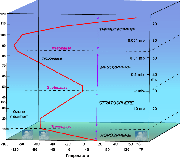
Click
on picture to enlarge at Apollo.Isc.vsc.edu
The average
temperature at Earth’s surface is 15ºC and this decreases with height
in the troposphere because its main source of heating is the earth’s
surface.
Temperature
increases with height in the stratosphere because of the relative
prevalence of ozone in this region (2-8 parts per million). As the
sunlight penetrates down through the layer the ozone molecules interact
with and transform the ultraviolet waves into infrared waves. The region
is heated from above. Coincidentally the transformation enables life on
Earth, as cellular structures cannot survive when exposed to the full
range of sun’s ultraviolet radiation.
Temperature
decreases with height in the mesosphere as it is heated from below.
Temperature
increases with height in the thermosphere, which includes the
ionosphere, because it is heated from above. Temperatures here vary with
solar activity and may reach over 1550ºC though this is hard to measure
precisely because the air is so thin at this height. The distance
between the atoms and molecules at this altitude means we would
experience it has extremely cold.
In other words
the atmosphere is characterised by multiple alternating thermodynamics
at different altitudes. There is no uniform temperature gradient between
Earth’s surface temperature (range 58ºC to minus 89.6ºC) and Outer
Space where temperatures vary greatly depending whether an object is in
sunlight or in shadow. They range from minus 235ºC in the cosmic
background to 1000ºC, even millions of degrees, in the solar wind and
interstellar gas clouds.
It is the ratio
and distribution of gases of our planet’s atmosphere that enables life
on Earth. The balances are integral to almost every aspect of life. Life
as we know it depends, for instance, the surface temperature being
moderate and averaging about 15ºC.
If it were
possible for our atmosphere to consist only of nitrogen, oxygen and
argon (at present 99.9% of our atmosphere) then Earth’s surface
temperature would probably be about minus 18ºC and would be subject to
extreme temperature changes. These three gases plus some of the Trace
Gases have relatively little capacity to retain the infrared radiation
vital for Earth’s life forms. Earth’s surface would experience
extreme temperature changes similar to our moon’s surface, which
effectively has no atmosphere. In this situation incoming solar energy
from space is radiated directly back into space, particularly when a
surface region moves into shadow. The result is an extreme drop from
perhaps a mean of 107ºC to perhaps a mean of minus 153ºC.
It is the
existence of certain Trace Gases with a significant capacity to retain
thermal energy that results in Earth’s average surface temperature
being 33ºC degrees warmer and we enjoy our current average of 15ºC.
These Trace Gases have a vital capacity to act as warmers which is why I
symbolise them as the Warmer Trace Gases. They balance the effect of
Outer Space, which acts as a cooler.
Ozone
Ozone
is vital for life on Earth as we know it and in many ways is the essence
of the atmosphere in that it is very much a Trace Gas, has high powers
of leverage and is subject to constant, rapid transformations.
It is a Trace Gas
in that it is one or two parts per million of the atmosphere. It is a
Warmer Trace Gas in that is plays a significant role as a warmer of the
atmosphere and thus Earth’s surface.
91% of ozone
exists in the stratosphere where it resides in relatively dense
concentrations (still only 2-8 parts per million). This region is often
unhelpfully symbolised as the ozone
layer or blanket. Such symbol use fails to convey the trace
nature and leverage power of ozone.
There it reacts
with solar radiation. In this reaction ozone is transformed into oxygen
and atomic oxygen in the oxygen-ozone
cycle, 93-99% of the high frequency solar waves (the most
powerful ultra violet) are transformed into less powerful waves that are
less destructive of living cells on Earth and the stratosphere is warmed
so that it in turn warms the atmosphere below it. The result is a range
of flows and balances of chemicals and thermal activity that enables
life, as we know it. In turn biomass emits oxygen into the atmosphere,
which then becomes ozone, which enables biomass to exist.
While ozone is an
unstable molecule it has a relatively long life in the stratosphere. It
is relatively slow moving there and yet the oxygen-ozone cycle lasts
moments. Its concentration varies with height, with the region of Earth
and with the seasons. At low levels it is harmful to humans and we can
detect it in .01 parts per million of the atmosphere. Ozone is a vital
element of Earth’s atmosphere.
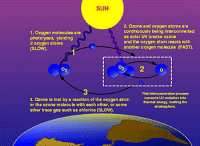
Click
on picture to enlarge at Wiki site
Earth
– the great transformer.
The nature of
Earth’s unique atmosphere means that only about 51% the solar energy
reaching the atmosphere’s outer limits from space actually reaches our
planet’s surface. About 30% is reflected directly back to space,
particularly by ice, snow and clouds, in what is known as the Albedo
Effect. About
19% is directly absorbed or transformed from very powerful ultraviolet
radiation into less powerful infrared
radiation in the interactions of sunlight with the atoms and molecules
in the atmosphere.
Infrared light
from the Sun only accounts for 49% of the solar heating of Earth’s
surface. The remainder of the heating occurs when radiation in the form
of visible light is absorbed by Earth’s surface and transformed into
infrared radiation.
This infrared is
then re-radiated into the atmosphere where some of it is retained by the
Warmer Trace Gases. Thus Earth can be seen a great transformer. Its
activity powers most of the atmosphere system.
As mentioned,
Oxygen, Nitrogen and Argon (99.9% of the atmosphere) play minor roles as
warmers. This is because they do not interact with infrared radiation.
However the molecular structure some of the Trace Gases such as water
vapour, carbon dioxide, ozone and also methane, nitrous oxide and the CFCs
have a considerable capacity to interact and so can absorb and emit
infrared radiation. Thus they act as warmers by retaining and radiating
infrared to surrounding air molecules and back to the earth.
Thermal energy
always travels from warmer regions to cooler regions. Thus air that is
warmer tends to move or convect through the atmosphere. We know this
movement of air masses as breezes, winds and hurricanes. They constantly
work to equalise overall temperatures, warming up cooler areas and
cooling down warmer areas. This constant movement of air masses around
the planet results in more moderate temperatures in both parts of our
planet exposed to sunlight and parts in shadow and darkness.
There is no
consensus about the relative impact of water vapour compared to the
other Warmer Trace Gases on the thermal balances of Earth’s surface.
Please note that these gases are commonly symbolised as “greenhouse
gases” by adherents of the Greenhouse religion. The role accorded
water vapour and other water forms and states such as clouds, oceans and
ice depends on the politics, spirituality and sector interests of
individuals and groups. Estimates of the impact of water vapour and
other water forms on Earth’ surface temperature vary from 0ºC by
those who deny their existence altogether to
95% by those who attribute almost all power to them.
Nor can there be
consensus about the exact role of water vapour. The transformations of
water, carbon, oxygen etc in the Earth’s thermal system are so
intimately interconnected by all manner of feedback systems and “radiative
forcings” of each other that it is probably impossible to
isolate their individual impacts.
For instance from
Junk Science:
..””there is
'competition' for available energy and significant greenhouse potential
is unrealized (carbon dioxide could absorb more than 3 times the energy
it currently does in the atmosphere were it not for competition from
clouds and water vapor, clouds alone could absorb 50% of available
energy but manage to capture just 14% and so on...).
So, despite there
being far more greenhouse gas in the atmosphere than required to achieve
the current greenhouse effect, something which has been true since
before humans discovered fire, evapo-transpiration and thermals
transport heat higher in the atmosphere where radiation to space is
increased. This is why Earth remains about 15 °C (288 K)
rather than about 77 °C (350 K).”
The
altitude at which a gas resides affects its potency as a warmer too. We
are talking about Trace Gases, gases that exist in parts per thousand of
the atmosphere and in ozone’s case, parts per million. All the Warmer
Trace Gases have various and vital roles.
With this caveat
in mind I suggest that it is water vapour and other water forms that
dominate our experience of the life-enabling thermodynamics at Earth’s
surface. There is good reason why Earth can be symbolised as the
“water planet” and water in all its forms is at the essence of our
primal experience. The contribution of water vapour to the 33ºC
temperature difference attributed to Warmer Trace Gases may be greater
than all the other gases combined. Little is known about cloud
formation. For instance variations
in solar activity may affect ionisation of the atmosphere and
this affects the abundance of aerosols that serve as the nuclei of
condensation in cloud formation and this in turn affects cloud
distribution and their abledo effect. Clouds may well, on balance, add
further to water’s warming effect on Earth’s surface to a
significant degree too.
The illustrations
in most education resources suggest Earth’s surface is mainly warmed
by sunlight. This is particularly true of those that evoke images of our
planet residing in a greenhouse. This fails to communicate the real
dynamics. The Suns rays are concentrated on regions
sited between 23
degrees north and 23 degrees south of the equator. This is the only
region where the Sun is directly overhead here. All other regions on
Earth receive solar radiation at an angle, making it increasingly less
intense towards the poles and nearly half of the planet is in darkness
at any time. The true situation is that the atmosphere has twice the
warming effect on Earth’s surface that direct sunlight does. It
receives an estimated 168 Watts/square meter in directly from the Sun
and 324 from the atmosphere.
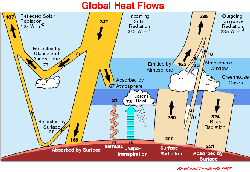
Click
on picture to enlarge at UCAR site
In summary the
atmosphere is a very dynamic and profoundly organic system in which many
of the vital balances that sustain us rest in the existence of trace
gases with very powerful leverage. It is essential that we constantly
search for symbol uses that reflect and communicate this dynamic change
and these exquisite balances. The atmosphere is a place characterised by
constant movement where each molecule is in continual dance, vibrating
with the thermal energy flows. The vast uprisings and passings in which
clouds form towering, powerful columns ten miles high and dissipate in a
few brief minutes is a visible manifestation of our atmosphere. They are
reflective of the greater process and are reminders of a far more
awesome state -our invisible atmosphere.

Back to top
Guide
to evaluating “climate education” programmes.
The following
list contains factors to be considered when evaluating “climate
education” programmes. It is incomplete in both its selection and its
explanation of them.
The framing of
the factors is derived from the central assumptions contained in the
Principle of the Conservation of Energy and the Uncertainty Principle of
Energy. In particular it is derived from the assumption that the essence
of the universe(s) is continual change and Homo sapiens are extant to
the extent they remain stewards of their actions within this flux of
change.
It is assumed
that every aspect of an education programme is symbolic, including the
life style of the person delivering the programme, the choice of
delivery (car, bus, Internet, book text etc) and the media is the
message.
Every aspect
within the framework of the education resource being evaluated is also considered to be symbolic,
including the layout, the titles, pictures, activities, words etc.
The value of a
symbol is determined by the relative degree that it resonates to
generate acceptance/denial of change and stewardship.
It is assumed
that symbols resonating acceptance of change/stewardship will tend to
generate behavioural responses based in sensations of connection, unity,
harmony, hope, compassion, science and enjoyment.
It is
assumed that symbols resonating denial of change/stewardship will tend
to generate behavioural responses based in sensations of alienation,
disintegration, dissonance, despair, cynicism, ignorance and misery.
It is assumed the
most sustainable changes to behaviour arise from the experience of
compassion and joy. Changes arising from the experience of fear and
hopelessness will tend to be unsustainable. Hence importance is given to
observing how an education resource presents evidence of unsustainable
behaviour and simultaneously provides insights that promote responses
and change based
in compassion and joy.
The list below
identifies key symbols used in the communication of climate issues. It
provides examples of how they can be employed in sustainable ways so
they resonate with acceptance of change/stewardship and how they are
commonly used, resonating in denial.
General rule: the more a climate education
programme is inclusive of and conserves the potential of the following
symbols then the more it will tend to generate an inspiring vision of
the atmospheric process and individual options. This in turn works to
generate a desire to live in harmony with amazing balances and flows of
the atmosphere.
Thought:
Teach
the invisible and the visible will teach itself.
List
: Symbol - use and relative impacts
Atmosphere/Greenhouse
Carbon
Compassion
Climate
&Change
Electricity
Energy
Global
Warming/Cooling
Greenhouse
Greenhouse
gases
Ozone
Power
Science
Trace
Use
Water
Atmosphere/Greenhouse

Click
on picture to enlarge at kidsgeo.com
*Acceptance:
Atmosphere = atmosphere (characterised by dynamic, organic,
multi-layered process characterised by considerable convection capacity.
*Denial:
Atmosphere =greenhouse, greenhouse Earth, greenhouse world (characterised
by suppression of air convection, image of human technology, control,
artificial.
*Acceptance Atmospheric
(Thermal) Effect =an effect of the atmosphere which warms up Earth's average
surface temperature by about 33ºC.
*Denial Greenhouse
Effect =Atmosphere is symbolised as greenhouse = works like a
greenhouse and so warms up Earth's average surface temperature by about
33ºC.
*Acceptance Human-induced
Thermal Build-up = human activity is raising average surface temperature
of Earth.
*Denial: Enhanced
Greenhouse Effect =Atmosphere is symbolised as greenhouse = works
like a greenhouse and so warms up Earth's average surface temperature by
about 33ºC
and human activity is raising the temperature of the greenhouse Earth..
*Acceptance Warmer
Trace Gases = Certain trace gases that work to warm up Earth's average
surface temperature by about 33ºC.
*Denial: Greenhouse
gases = Atmosphere is symbolised as greenhouse = some gases in the
greenhouse work to warm up Earth's average surface temperature by about
33ºC.
Comment:
The use of the greenhouse symbol stems from an insight of the great
mathematician and student of thermodynamics, Jean
Baptiste Joseph Fourier(1768–1830). About 1824, based on his
experiences in the thermal extremes of the Sahara desert he observed
that gases in the atmosphere increase the surface temperature of
Earth’s surface. He referred to M. de Saussure’s experiment which
showed that placing a thin sheet of glass on top of a black box exposed
to sunlight resulted in higher temperatures in the box.
This is analogous
to what occurs in greenhouse and eventually the warming effect of the
atmosphere came to be expressed in the greenhouse effect symbol.
Historically the greenhouse
symbol has been associated with wealth, power and control over nature in
Europe. Wealthy estates vied to show their might by producing tropical
fruits such as oranges and pineapples in their cold climates. The
greenhouse symbol resonated profoundly with the belief systems that
drove the Industrial Revolution. Foremost of these beliefs is that it is
mankind’s God-ordained
role to have dominion over all life on the planet.
(God
created all living creatures human beings on the sixth day of Creation.
"Male and female created he them; and blessed them, and called
their name Adam..." (Genesis 5:2). "Adam" is a general
term, like "Man" and could refer to the whole of humankind.
God blessed them to be "fruitful and multiply" and ordained
that they should have "dominion over the fish of the sea, and over
the fowl of the air, and over the cattle, and over all the earth, and
over every creeping thing that creepeth upon the earth" (Genesis
1.26-27 King James Version 1611)
Greenhouses
became integral to the university ethos and associated with knowledge
and a sense of power over “Nature” too. They came to symbolise Earth
as a laboratory for Homo sapiens, which fitted with the emergence of new
uses of the science symbol with the Industrial
Revolution.
Through this
period the science symbol became associated with a supposedly
objective way of observing and collating knowledge that is the preserve
of an elite of men (and more recently women) symbolised as scientists
who are able to stand apart from and experiment with Nature.
By the middle of
the 19th Century massive greenhouses were being built as
symbols of national power. In 1851 the construction of the Crystal
Palace , built to house the Great Exhibition of Britain’s industrial
might and display its dominion over the planet, coalesced visions of
greenhouses with the technological might and superiority of Homo sapiens (especially the
Britannicus group) and the new use of the science symbol.

Click
on picture to enlarge at makingthemodernworld.org
The Industrial
Revolution and its associated symbol-uses spread throughout the world.
The symbol uses became central to the faith of hundreds of millions of
Homo sapiens and the belief that Homo sapiens are separate from and rule
over Nature transformed economies worldwide. The symbol uses resonate to
generate beliefs systems born of sensations that humans are not bound by
“natural laws” , thus populations and economies can expand without
limit.

Click
on picture to enlarge at vforteachers site
Adherents of this
new religion included industrialists, academics, so called
“scientists”, theologians, politicians and a wide range of
influential human beings. The new religion became manifest in the daily
activities of the greater masses of Homo sapiens. By the mid 20th
Century the essence of the religion had crystallised into the Greenhouse
Earth symbol. It became common for schools and other education
agencies such as “environmental education” groups and NGO’s to
propagate images of planet Earth residing inside a greenhouse. By the
1980s a raft of symbol uses evoking this image of Greenhouse Earth
dominated discourse in schools and the media about the nature of the
thermodynamics of Earth’s surface and the role of Homo sapiens.
This discourse
dates from the earliest days of the Industrial Revolution when it
was manifest as both a desire to understand how the atmosphere works and
as a conflict between the short-term interests of the owners of the new
combustion engines and the longer-term interests of large groups of
people whose health was more directly put at risk by the polluted
air. The same inquiry and conflict continues in the discourse
today. Now the conflict is now manifest as concern for the balances of
Trace Gases in the atmosphere and how global impacts of the
Industrial Revolution may be putting the balances that sustain Homo
sapiens at risk.
The public
discourse is dominated by two groups. One group argues that human
activities can and are affecting affect the Trace Gas balances of the
atmosphere in ways that put Homo sapiens at risk. The contra group
argues that even if human activities can impact on the balances there is
not sufficient evidence that this puts us at any risk. Both groups are
firm adherents of the Greenhouse religion and this is manifest in their
relatively similar unsustainable uses of technology and consumption of
resources.
It is also
manifest at all levels in classroom activities that attempt to
communicate the nature of the atmosphere. The activities are dominated
by evocations of technology and most work to create associations between
the atmosphere symbol and greenhouses,
classrooms, cars, bottles and other such symbols. There is active
avoidance of activities that communicate the nature of trace existences
and leverage.
In
summary, this use of the greenhouse symbol is born of
sensations of aversion and craving. It expresses the user’s aversion
to stewardship of the impact of their activities on atmospheric balances
and intimacy with the atmosphere’s dynamic process. Simultaneously it
expresses the user’s craving to be immune from the impacts their
activities. The greenhouse image supports these responses by providing
sensations of control, calm and insulation, thus muting the sensations
of dissonance generated by knowledge that the user’s activities may
well be working to make the atmosphere a more dangerous place for Homo
sapiens. Thus the discourse fails to generate activities that conserve
atmospheric balances and senses of harmony and unity.
This use of the greenhouse symbol is not
born of a state of science and it thus obscures reality. It actively
suppresses most of the sensations of dynamism, variety, organics, power,
movement, transience and trace existence the individual must experience
it they are to truly reflect and be at one with the atmosphere.
Return
to symbol list
Use of carbon symbol
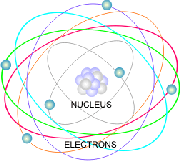
*Acceptance:
carbon = common element in the universe(s) found in all living matter.
*Denial: carbon =
carbon forms that can be made profitable for some Homo sapiens to trade
*Acceptance:
carbon trading = symbol use non-existent for individual accepts role as
steward of flow of carbons through the universe(s)
*Denial: carbon trading = mechanism for individuals to trade away
their roles as stewards of carbon flows.
*Acceptance:
carbon valuing = the placing of a value on a carbon form as act of
stewardship by the individual and/or their society. This takes the form
of individual and/or communal tax on the use.
*Denial: carbon valuing = something that is done by corporate entity
symbolised as The Market.
*Acceptance:
carbon neutrality = symbol use non-existent for individual is aware that
their every action affects the flows of carbon in its myriad forms
through the universe
*Denial: carbon neutrality = mechanism by which individuals identify
a few, not all, consequences of their use of select carbon forms and by
use of money or other means attempt to ameliorate the impacts.
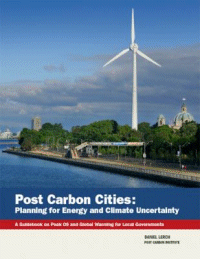
Click
on picture to enlarge at postcarboncities.net
*Acceptance:
Decarbonisation of the world = symbol use non-existent as notion is
impossible and meaningless.
*Acceptance: Wise uses of carbon forms = use results in
sustainable uses of carbon forms.
*Denial: Decarbonisation of the world = removal of some carbon
forms from the world
*Acceptance:
Low/high carbon economy = symbol use non-existent for it is immaterial
how much of a carbon form is used. It is the sustainability of the use
that is material.
*Acceptance:
Low/high risk uses of a carbon form =use of stated carbon form presents
relatively low or high risks
*Denial: Low/high carbon economy = economy dependent on small or
large quantity of a carbon form or forms.
*Acceptance:
Post carbon world/city/individual = symbol use non-existent
*Acceptance: Carbon responsible world/city/individual = uses of
carbon are sustainable and harmonious with vital flows and balances.
*Denial: Post carbon world/city/individual = user makes
no use of carbon form(s).

Click
on picture to enlarge at Linfield.edu
*Acceptance:
Change =change (the natural order, healthy vital process)
Denial: Change =bad
*Acceptance:
Climate change= climate change (the natural order) Some specific changes
work to sustain Homo sapiens. Some specific changes work to endanger
Homo sapiens.
Denial: Climate change = bad
*Acceptance:
Human Atmospheric Impacts = Human induced or anthropogenic changes to
climate balances occurs.
*Denial: Climate change = human induced or anthropogenic climate
change = bad.
*Denial: Human Atmospheric Impacts = impossible/
*Acceptance:
Conserving climate balances = Ensuring our activities work do not
generate risky changes to climate balances.
*Denial: Fighting climate change =climate is the enemy
*Acceptance:
Harmonizing with the climate = Being in harmony with its sustaining
balances and flows.
Denial: Stopping climate change = Fighting climate change =
climate is the enemy.
*Acceptance:
Human-induced Thermal Build-up = Human’s Atmospheric Impact (net
warming up) = bad?, high
risk?
*Denial: Climate change = global warming = bad.
*Acceptance:
Human-induced Thermal Cool-Down = Human’s Atmospheric Impact (net
cooling down) = bad?, high
risk
*Denial: Climate change = global cooling = bad.
Return
to symbol list
Use of Compassion symbol

*Acceptance:
Compassion = sympathetic consciousness of the suffering of oneself and
of others with a desire to alleviate it =sympathetic
consciousness of others' distress together with a desire to alleviate it
= central characteristic of
humanity.
*Denial: Compassion = symbol not used.
*Acceptance:
Compassion = the fundamental requisite for science to exist
*Denial: Thought process = the the
fundamental requisite for science to exist
*Acceptance:
Compassion = living in harmony with the climate flows and balances of
the atmosphere that sustain us = loving response/relationship required
*Denial: Fighting climate change/global warming =
atmosphere is an enemy = militaristic response/relationship required
*Denial: Stopping climate change/ global warming =
atmosphere is an enemy= militaristic response/relationship required
Return
to symbol list
Use
of electricity symbol

Click
on picture to enlarge at NASA
*Acceptance:
Electricity = symbol of all electrical phenomena
*Denial: Electricity = Bulk-generated electricity.
*Denial: Electricity = flow of power or charges down a wire
*Acceptance:
Bulk-generated electricity = Bulk-generated electricity =
electrical resources generated by very large, centralised turbines
*Denial: Bulk-generated electricity = power = energy
*Acceptance:
Micro-generated electricity = electrical generators in one Megawatt
range
*Denial: Micro-generated electricity = symbol not used
*Acceptance:
Dwelling-generated electricity = electrical generators in one watt range
*Denial: Dwelling-generated electricity = symbol not used
Comment.
There is no such thing as "electricity". Rather the symbol
describes all electrical phenomena. Each phenomena has its own symbol.
Failure to use that symbol and say that an electrical phenomenon is
electricity (or power or energy) is to deny the myriad forms of
electrical phenomena.
Return
to symbol list
Use of energy symbol

Click
on picture to enlarge at wiki site
*Acceptance:
energy = the potential of the universe(s)
*Denial: energy = Bulk-generated electricity
*Denial: energy
= fossil fuels (coal, mineral gas, mineral oil)
*Acceptance:
energy stocks = all resources available to Homo sapiens
*Denial: energy stocks = Bulk-generated electricity and/or fossil fuels
*Acceptance:
energy sector = all uses of energy in any activity
*Denial: energy sector = Bulk-generated electricity and fossil fuels
sector
*Acceptance:
energy efficiency = use of the bounteous energy potential in ways that
conserve the flows and balances of its transformation that work to
sustain Homo sapiens.
*Acceptance: energy efficiency= continual evaluation of relative
efficiency of all activities.
*Denial: energy efficiency =using less energy.
*Denial: energy efficiency =deprivation
*Denial: energy efficiency =single evaluation of efficiency of an
activity
*Acceptance:
Energy conservation = Principle of Energy conservation = energy is
conserved and can be neither created, destroyed or conserved for it is
by its very nature conserved = Homo sapiens have a bounteous options of
how they use its myriad transformations.
*Denial: energy conservation = act by which humans conserve
energy = humans deprive themselves of energy i.e. use less energy
regardless of sustainable optional uses available.
*Acceptance:
energy expert = person whose life is sustainable and who is able to
accurately reflect reality (all is change/stewardship) so they
experience the state of harmony.
*Denial: energy expert= person who is expert on Bulk-generated
electricity and fossil fuels and/or their trades.
*Acceptance:
energy crises =non-existent, for the potential of the universe(s) is
bounteous.
*Denial: energy crises = loss of access to cheap Bulk-generated
electricity and or fossil fuels.
*Acceptance:
energy use crises = crises stemming from unsustainable uses of resources
– often caused when an energy form is confused with energy
*Denial: energy use crises = symbol use
non-existent, for energy is the problem.
Return
to symbol list
Use of Global
Warming symbol
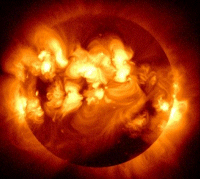
Planet
Earth is subject to constant warming from the sun even as it is
subject to constant global cooling.
Click
on picture to enlarge at NewScientist site
*Acceptance:
Global warming = global warming = no net change of temperature from
transfer of thermal energy (i.e. warming = cooling) = healthy, helpful,
minimal risk
*Denial: Global warming = global warming up = net change of
temperature from transfer of thermal energy (i.e. warming greater than
cooling) = process is dangerous and high risk
*Acceptance:
Global cooling = global cooling = no net change of temperature from
transfer of thermal energy (i.e. warming = cooling) = healthy, helpful,
minimal risk
*Denial: Global cooling = global cooling down = net change of
temperature from transfer of thermal energy (i.e. cooling greater than
warming)
= process is dangerous and high risk
*Acceptance:
Human-induced Thermal Build-up = Human’s Atmospheric Impact (net
warming up) = bad?, high
risk?
*Denial: Global warming = Climate change = bad
*Acceptance:
Human-induced Thermal Cool-Down = Human’s Atmospheric Impact (net
cooling down) = bad?, high
risk
*Denial: Global cooling = climate change = bad.
Comment:
The universe(s) is in a state of being. This state is characterised by
constant change and transformation. One manifestation of this change is
thermal energy, which is constantly being transferred from warmer areas
to cooler areas. Hence all elements of the universe(s) are subject to
continual warming and cooling. When warming =cooling the net temperature
of a form or object remains constant e.g. the human body form is
sustained at a temperature of 36.8 °C
±0.7 °C and the average surface temperature of planet
Earth is sustained at about 15°C.
Return
to symbol list
Use of greenhouse symbol

Click
on picture to enlarge at wiki (Germany)
*Acceptance:
greenhouse = rigid structure built by humans that uses transparent or
transluscent materials (glass, plastic etc) to insulate and suppress the
convection of air warmed by sunlight or other sources
*Denial:
greenhouse = Earth's atmosphere = dynamic system with high thermal
convection capacity
*Acceptance:
greenhouse = prime example of human ability to exploit airs properties
(low thermal conduction capacity and high thermal convection capacity)
to create thermal insulation in clothing, dwelling and other
technologies
*Denial:
greenhouse = Earth's atmosphere = prime example of the power of air's
thermal convection capacity.
*Acceptance:
Greenhouse = place of calm, peace and tranquility where normal seasons
and geographical limits do not prevail.
*Denial: Greenhouse = place
of turbulence, winds, thermal variation and extreme weather events.
Return
to symbol list
Use of ozone symbol
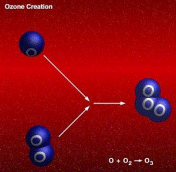
Click
on picture to enlarge at srh.noa.gov
*Acceptance:
Oxygen-ozone cycle = very dynamic process in which oxygen molecules are
transformed into ozone and oxygen atoms
and vice versa in reactions with high frequency solar radiation =
warming effect on stratosphere.
*Denial: Oxygen-ozone cycle
= symbol not used or glossed over.
*Acceptance:
Ozone = potent Warmer Trace Gas
*Denial: Ozone = greenhouse
gas
*Acceptance:
Ozone region/zone = region of stratosphere in which 91% of ozone resides
(2-8 parts per million)
*Denial: Ozone layer =
blanket of ozone in stratosphere = ozone is dense in the stratosphere
Comment.
As well as having a potent thermal effect the existence of ozone in the
stratosphere reduces the rate that solar radiation that is harmful
to cell structures reaches Earths surface.
Return
to symbol list
Use of power symbol

Click
on picture to enlarge at nanovic.com
*Acceptance:
power = rate at which energy or the potential of the universe(s) is
manifest.
*Denial: power =
Bulk-generated electricity
*Acceptance:
power plant = all mechanisms (including technology, biomass, tectonic
and celestial capable of transformations.)
*Denial: power plant =
mechanism for generating Bulk-generated electricity
*Acceptance:
utility wires/poles = all wire and pole grids capable of transmitting
electrical charges used in communication and by machines used for
heating/cooling and moving objects in human structures
*Denial: power wires/poles
= wire and pole grids capable of transmitting Bulk-generated electricity
*Acceptance:
power supplies = all sources of power
*Denial: power supplies =
supply of Bulk-generated supplies
*Acceptance:
power loss/failure/collapse = symbol use non-existent for power is as
bounteous as energy.
*Denial: power loss/failure/collapse = loss of access to supply of
Bulk-generated electricity
Return
to symbol list
Use of science
symbol
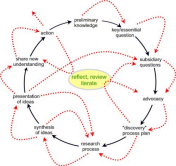
Click
on picture to enlarge at i-learnt.com
*Acceptance:
science = state of being founded in compassion and inquiry
*Denial:
science = way of thinking and experimentation
*Acceptance:
science = wisdom in actions
*Denial:
science = body of knowledge or expertise
*Acceptance:
scientist = state common to all people capable of compassion and inquiry
- state that enables the development of art, language and civics
*Denial:
scientist = elite minority who inhabit an entity symbolised as “the
science fraternity” and who are schooled in particular way of thinking
and the body of knowledge called “science”
Comment.
Science is a state of being. The requisites for the state to exist are
the experience of compassion, honesty, inclusiveness, sharing,
generosity of time, inquiry and reflection. If any of these requisites
do not exist then science also ceases to exist. When all these
requisites exist then language, arts, civics and all that we know as
civilisation flourishes.
This use of the science
symbol sustains acceptance of change/stewardship for it is inclusive of
all human beings. When the individual experiences this state of being
then the knowledge generated by the process of honest enquiry is integral to
the individual’s lifestyle. The body of knowledge born of science
becomes their actions and not just their talk.
The current
dominant use of the science symbol is clearly exclusive and often lacks
many of the other requisites too. Contemporary use reveals a denial of
change/stewardship in that the general lifestyle of the individual can
be dissociated from the process and the body of knowledge.
Return
to symbol list
Use of trace
symbol

Elements
that exist in miniscule proportions can have mighty powerful
effects.
Click
on picture to enlarge at noteworthygroup.com
*Acceptance:
trace = existing as tiny proportion of a system
*Denial: trace = symbol not
used.
*Acceptance: =
trace gas = gas existing as tiny proportion of atmosphere = typically a
fraction of 0.1%.
*Denial: trace gas = symbol
not used.
*Acceptance: Warmer
Trace Gases = gases constituting less that 0.1%
of the atmosphere that have a vital and unique warming effect of about
33ºC
*Denial: greenhouse gases =
gases in the (greenhouse) atmosphere with a vital and unique warming
effect of about 33ºC
*Acceptance: Most
potent Warmer Trace Gases = water vapour, carbon dioxide, methane,
nitrous oxide, CFCs and ozone
*Denial: Most potent
greenhouse gases =carbon dioxide, methane, nitrous oxide and the CFCs
Comment:
The use of the trace symbol promotes teaching activities
communicating the nature of tiny proportions and leverage. In this
case gases that exist in very tiny proportions have a disproportionately
large impact on thermal balances at Earth's surface. Over 99.9% of the
gases in the atmosphere have a relatively tiny thermal impact.
Return
to symbol list
Use of the use
symbol

Human
use of atmosphere
Click
on picture to enlarge at World Meteorological Org
*Acceptance:
Use = the act of using
*Denial: Use = symbol not
used.
*Acceptance:
Climate (atmosphere) use problem = human's use of climate (atmosphere) is unsustainable
*Denial: Climate change =
global warming = the problem
*Acceptance:
Human-induced thermal Build-up problem = human activities are resulting in a thermal
build-up in the atmosphere that may put them at risk
*Denial: Climate change =
global warming = problem
*Acceptance:
Use of resource = unsustainable
*Denial: Energy crises =
energy is the problem
*Acceptance:
Use of Bulk-generated electricity = unsustainable = problem
*Denial: power
crises/shortage = power is the problem = energy is the problem =
electricity is the problem.
*Acceptance:
Stewardship = individual accepts responsibility for their use of a
resource
*Denial: Stewardship =
individual divests responsibility onto another entity, often symbolised
as The Market, for their use of a resource
Comment:
Homo sapiens have a vast capacity for denying their roles as
stewards. The denial is often manifest as a tendency to find the use
symbol inconvenient to use. This often has fatal consequences.
Return
to symbol list
Use of water symbol

Click
on picture to enlarge at flikr
*Acceptance:
Water = defining feature of planet Earth
*Denial: Water = not
mentioned or peripheral to discussion of climate processes on Earth’s
surface.
*Acceptance:
Water vapour =vital element of climate
*Denial: Water vapour = not
mentioned or peripheral to discussion of climate processes
*Acceptance:
water vapour = trace gas
*Denial: water vapour =
greenhouse gas (see greenhouse symbol)
Denial: water vapour = non-trace gas
*Acceptance:
water vapour =relatively localised phenomenon with barely detectable
amounts of water vapour above the troposphere and at the poles.
*Denial: water vapour =
abundant gas of indeterminate distribution.
Comment:
Water, in particular water vapour, is frequently dismissed from
discussion. There is a tendency for those involved in promoting carbon
trading to omit or diminish its role. Often they limit discussion to sea
level rises and weather ‘events’ i.e. extreme events such as
droughts and deluges. The omission may reflect the resource author’s
conclusion that they cannot profit their income or career from trading
water vapour and or it may reflect the fact that the water cycle through
the atmosphere is extremely rapid (approximately10 -14 days on average.)
and dynamic. This makes analysis and predictions of atmospheric
processes very difficult.
In the average
localised thunderstorm 400,000
tons of water vapour condenses within the cloud and the energy
is released is the equivalent of 12 times that of the nuclear bomb
dropped on Hiroshima.
Water in all its
forms constantly creates variation in Earth’s albedo.
In general high
clouds tend to warm up the Earth’s surface and low clouds tend to cool
it down.
It is possible cosmic
rays affect the formation of clouds through possible effects on
production of cloud condensation nuclei though there is little knowledge
of this process.
Return
to symbol list
Reviews
of Evaluator resource
Link
to Sustainability Principle of Energy
Link
to the Compassionate Curriculum Framework
Return
to Update Page
Return
to the Welcome Page

Back to top
|






























